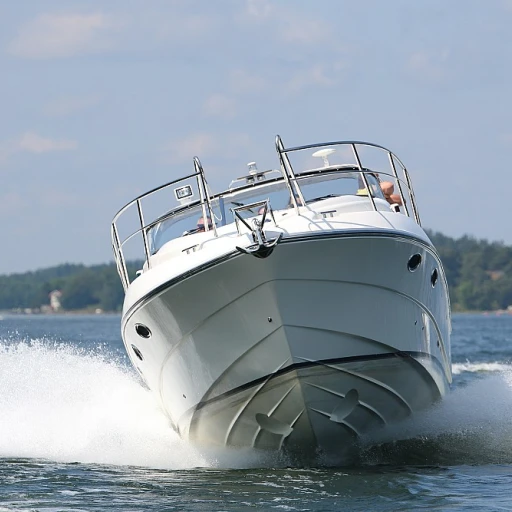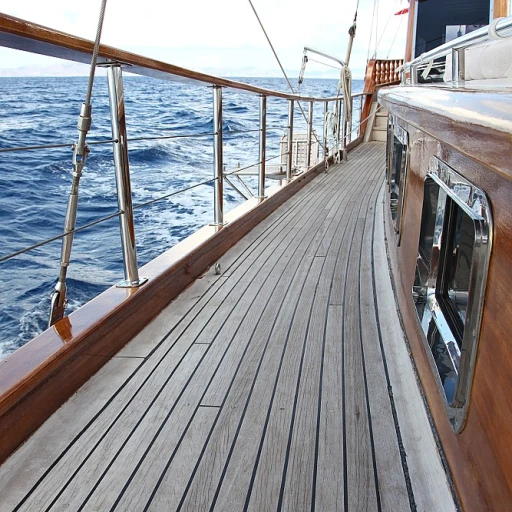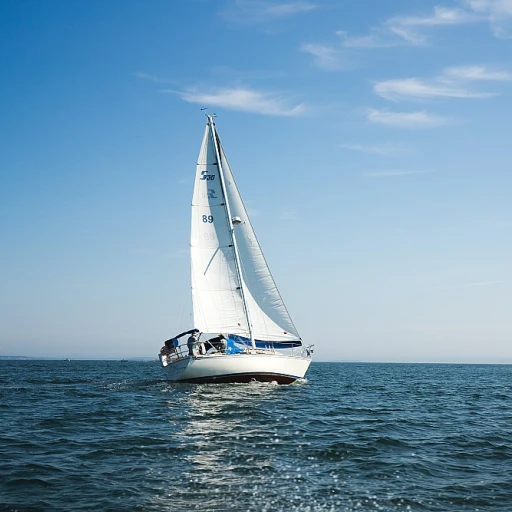
Understanding the Importance of Boom Security
The Critical Role of Boom Security in Sailing
Securing your sailboat's boom is paramount for not just smooth sailing, but also for ensuring the safety and security of all onboard. The boom, along with the mast, contributes to the essential framework that holds the main sail in place. This not only optimizes the boat's performance but also impacts the overall sailing experience. When the boom is not properly secured, it can lead to equipment damage, inefficient sailing, or even accidents, especially in rough waters or during unexpected weather changes.
The intricacies of boom security relate directly to the efficiency of sail ties and reefing practices. Ensuring the top, foot, and boom sail are firmly tied with appropriate knots such as the reef knot, is crucial. This step not only keeps the sail boom stable but also allows for quick adjustments if one needs to reef the main sail quickly. Essential elements like reefing lines, the reef tack and clew, and the location where they join need to be managed professionally to maintain a tight ship, especially when crossing challenging seas.
Further emphasis on the correct use of accessories and tools is needed—every piece, from the reefing lines to the bolt rope, plays its part. The investments made in quality materials for the boom are just as significant as the time invested in learning the correct techniques to tie and secure it. Tying these elements around the boom carefully affects the boat’s performance, from knotting to adjusting the loose-footed sail to coordinating with lazy jacks.
Recognizing these requirements helps avoid common mistakes that could jeopardize the boat’s dynamics. Whether it's learning how to use a timber hitch effectively or how to ensure all connections and lines are precisely adjusted, master these skills to prevent mishaps and improve maneuverability on open water.
Understanding these components lays the groundwork for safer and more enjoyable sailing adventures, while improper handling of the boom can lead to significant setbacks and risks.
Materials and Tools for Tying Around the Boom
Essential Materials and Tools for Securing Your Boom
When it comes to securing your sailboat's boom, having the right materials and tools is crucial. The boom, which holds the foot of the main sail, needs to be properly tied to ensure safety and efficiency while sailing. Here’s a breakdown of what you’ll need:
- Sail Ties: These are essential for tying around the boom. Opt for durable materials that can withstand the elements. Sail ties should be long enough to wrap around the boom and secure the sail tightly.
- Reefing Lines: These lines are used to reduce the sail area in strong winds. They run through the reef points on the sail and are tied around the boom to keep the sail secure.
- Rope and Lines: High-quality ropes are necessary for various knots and hitches. Consider using lines that are resistant to UV rays and saltwater.
- Knots and Hitches: Learn essential knots like the reef knot and timber hitch. These knots are crucial for securing the sail and boom effectively.
- Tools: A good set of tools, including a knife and a fid, will help you manage lines and ties efficiently. For more on essential tools, check out this guide on sailing navigation tools.
Understanding the location of each component is vital. The boom sail, main sail, and mast must be joined correctly to ensure the boat's stability. Pay attention to the reef clew, reef tack, and bolt rope, as these are critical points where the sail is secured to the boom.
In the next section, we will dive into a step-by-step guide on how to tie around the boom effectively, ensuring your sail is secure and ready for any sailing adventure.
Step-by-Step Guide to Tying Around the Boom
Experienced Techniques for Securing Your Boom
Securing your sailboat's boom requires a strategic approach, ensuring both the safety and efficiency of your sailing experience. To achieve this, it's crucial to perform each step meticulously, starting from the correct positioning of your sail boom.- Locating the Right Position
- Ensure your main sail is set appropriately, with the reef point and reef tack aligned.
- Position the boom at an optimal height, keeping an eye on the sail reefing lines.
- Collecting Your Tools
- Have your sail ties ready. These are essential for tying around the sail boom.
- Prepare your ropes, ensuring that they are suitable for easy tying and untying, such as a reef knot or timber hitch.
- Tying the Sail Ties
- Apply the ties around the boom securely. Begin from the mast and move towards the rear of the boom.
- A reefing technique might be required for a loose-footed sail. Address each reef clew and reefing lines properly.
- Employing the Right Knots
- Use knots like the reef knot or timber hitch to secure the lines.
- Ensure the knots are tight, but allow some flexibility for adjustments during sailing.
- Testing the Setup
- Pull at the lines to check for any slack, ensuring they are snug around the boom.
- Observe the main sail while simulating sailing conditions, ensuring the sail boom and reef lines remain firm.
Common Mistakes and How to Avoid Them
Common Pitfalls in Boom Security
Securing your sailboat's boom is crucial for safe and efficient sailing, but it's easy to make mistakes that can compromise your efforts. Here are some common pitfalls to watch out for:
- Incorrect Knot Usage: Using the wrong knot, like a simple hitch instead of a reef knot, can lead to a loose boom. Ensure you're using the appropriate knots, such as the timber hitch or reef knot, for a secure hold.
- Poor Location of Ties: Placing sail ties in the wrong location can affect the balance and tension of the main sail. Make sure ties are evenly distributed around the boom and mast to maintain stability.
- Overlooking Reefing Lines: Forgetting to properly secure reefing lines can result in a loose footed sail, which can be dangerous in strong winds. Always double-check that reefing lines are tight and secure.
- Ignoring the Foot Sail: The foot of the sail is often overlooked, but it plays a vital role in boom security. Ensure the foot sail is properly tied around the boom to prevent unwanted movement.
- Neglecting Regular Checks: Regularly inspecting your boom sail setup is essential. Look for wear and tear on sail ties and lines, and replace them as needed to avoid failures during sailing.
Tips to Avoid Mistakes
To prevent these common mistakes, follow these tips:
- Familiarize yourself with different knots and their uses. Practice tying them until you can do so confidently.
- Plan the placement of your ties and lines carefully, considering the balance and tension required for your specific boat and sail configuration.
- Regularly inspect your boom and sail setup, especially before long trips or in changing weather conditions.
- Stay updated on innovations and trends in boom security to incorporate new techniques and materials that can enhance safety and performance.
Maintenance Tips for Long-Lasting Boom Security
Maintenance Routines to Ensure Durability
Keeping your sailboat's boom securely tied isn't just about mastering the techniques but also maintaining them to ensure longevity. Regular maintenance can prevent wear and tear on your sail ties, reef lines, and knots, which can compromise the security of the boom during sailing.- Inspect Ties and Lines: Before you set off, make it a habit to check your sail ties and reefing lines for signs of fraying or brittleness. Pay close attention to areas around boom and mast, as these are stress points.
- Monitor the Boom Hardware: The boom sail hardware, such as attachments and reefing hooks, should be regularly examined for corrosion or damage. This ensures that your reef clew and reef point attachments remain secure when the main sail and foot sail are exposed to various sailing conditions.
- Keep it Clean: Saltwater exposure can lead to buildup and corrosion over time. Regularly rinse the sail ties, boom, and mast with fresh water to prevent salt deposits from affecting their structural integrity.
- Re-tie Periodically: Sail ties and hitches like the reef knot, timber hitch, and bowline should be retied to ensure they haven't loosened. This is particularly important for loose footed sails that require more attention to binding points.
- Use Quality Materials: Investing in high-quality ropes and lines, such as those resistant to UV and abrasion, will extend the life of your boom's security. Consider advancements in materials that offer increased durability and strength.
Innovations and Trends in Boom Security
Innovative Approaches to Sailboat Boom Security
The world of sailing is constantly evolving, with new trends and innovations poised to enhance how we secure our boats, specifically the boom. As you continue to take necessary steps to ensure the boom is tied and secured effectively, exploring recent innovations can be a game-changer for your sailing experience.
One of the emerging trends is the use of high-tech materials in sail ties and reefing lines. These materials not only offer increased durability but also reduce the effort needed to maintain tension and resilience against the elements when tying around the boom. Additionally, incorporating synthetic lines that possess UV resistance helps in maintaining the integrity of your ties and preventing untimely wear.
Another innovation making waves is the adjustable lazy jacks system. This setup is becoming increasingly popular as it supports a more streamlined reefing process. By enabling quicker adjustments and reducing the risk of entanglement, it simplifies the manier in which the boom sail is secured. Moreover, pairing this system with a loose-footed main sail can offer better lift and ease during strong winds.
Let's also talk about automation. The integration of motorized systems is paramount for more sophisticated racing yachts. These systems work in concert with the manual methods you've learned to enhance efficiency and ensure consistency when securing the sail boom. Though such systems may not be suitable for all boats, they provide an insight into future possibilities for current sailors.
Finally, smart technology is starting to carve out its niche within sailing. From applications that provide guidance on knotting techniques like the timber hitch or reef knot, to systems that monitor the tension along the reef lines, going digital can potentially help avoid common mistakes and ensure that your setup is always optimal.
Staying informed about these advancements can give you a strategic advantage, making your time on the water not just safer but also more enjoyable. Whether you embrace the latest technology or stick with tried and true processes, the key is ensuring that security remains a top priority.













